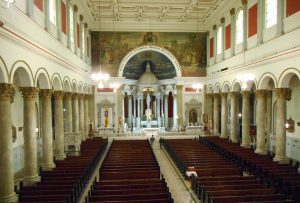Archdiocese wants to shutter historic Pilsen church but parishioners resist
Jack McCarthy — April 20, 2016

The interior of St. Adalbert’s Romanesque Revival church, 1650 W. 17th St., is a well-preserved gem with ornate stained glass windows, marble statues and an impressive — if only partially working — 1914 W.W. Kimball pipe organ. (Photo by Jack McCarthy / Chronicle Media)
The twin brick steeples are obscured by scaffolding, but St. Adalbert Roman Catholic Church faces a more worrisome problem that new mortar can’t fix.
The Pilsen landmark — a gateway church for thousands of immigrants during more than a century of service — faces a shutdown by the Archdiocese of Chicago.
St. Adalbert’s impending closure is part of a series of consolidations of Pilsen area churches and schools due to a dwindling number of parishioners and priests.
No official closing date has been announced for the parish, which once numbered 4,000 members and had 2,000 students enrolled in a school.
Richard Olszewski, a fourth generation St. Adalbert’s parishioner, isn’t ready to give in.
He said supporters hope they can save the church by raising up to $3 million for repairs and ultimately move away from Archdiocesan supervision.
St. Adalbert’s plight got notice last week when Landmarks Illinois, a Chicago-based preservation agency, placed the church on its 2016 list of most endangered buildings in Illinois.
“There’s a lot of value, there’s a lot of history here,” Olszewski said. “We’re trying to save this, whatever we can, as a sacred place. We could get an order of (non-Archdiocesan) priests in here and they could run it and we could have more involvement.”
St. Adalbert supporters said they had raised $1.5 million toward repairs before the Archdiocese froze the account and ordered funds returned to donors.
Supporters set up a fundraising mechanism through the new St. Adalbert’s Preservation Society. But they also know they’re in a race against time.
The church was among 11 listings announced by Landmarks Illinois at a Springfield press conference last week highlighting endangered properties around the state.
Most are owned by governments or institutions but all share deteriorating conditions caused by a lack of maintenance and funding.
“Landmarks Illinois encourages the Archdiocese to partner with community and preservation organizations, the real estate community, and the City of Chicago’s Department of Planning and Development to assess and find reuses for the buildings (like St. Adalbert) planned for closure through a comprehensive planning process within their neighborhoods,” the group said in a statement.
Landmarks Illinois is a non-profit agency that advocates for preservation and reuse of historic properties in the state.
St. Adalbert was among several Cook County sites labeled as endangered, including the Prairie Style Cornell Store and Flats on East 75th Street in Chicago, the stately Harley Clarke Mansion in Evanston and neighborhood school buildings in Highland Park.
An auditorium and gymnasium at St. Charles’ Illinois Youth Center and Wauconda’s Lakewood Farms are among highlighted suburban locations.
Endangered downstate properties includes a century-old YWCA in Springfield, an Art Moderne-style Armory in Salem, a Works Progress Administration-era in Metropolis, Champaign High School and a Space Age style bank in East Alton.
Landmarks Illinois has released yearly endangered lists since a 1995 debut and the group claims that one-third of listed properties have been saved while 25 percent have been demolished.
“The rest are in varying stages between being continually threatened and rehabilitation,” the group said.
St. Adalbert’s iconic Romanesque Revival church, located at 1650 W. 17th St., has served as a community anchor for generations since opening in 1914.
Despite a crumbling exterior, the church is a well-preserved gem inside with ornate stained glass windows, marble statues and an impressive — if only partially working — 1914 W.W. Kimball pipe organ.
Located in a largely Mexican-American neighborhood that’s showing signs of gentrification, the church was built by Polish immigrants and their influence is evident by throughout the structure.
“We’re the Mother Church of the South and West Side for Poles. We were the largest parish for Poles back in the golden days of St. Adalberts.”
A February letter from Bishop Alberto Rojas confirmed the decision to close.
“Due to the extensive repairs needed and associated high costs, St. Adalbert Parish will close,” Bishop Rojas wrote. “We are still working through other details and time around the closure.”
When it happens, St. Adalbert supporters plan to quickly make a formal appeal.
“There’s no decree set yet for the closure, but once that hits we have 10 days to file to stop it,” Olszewski said. “And that could go for two years in Rome.
“When that decree comes we’re ready to go to Rome and fight it.”
In the meantime, St. Adalbert supporters plan a fundraising event on April 23 at the church.
More information is available at stadalbertchicago.org







